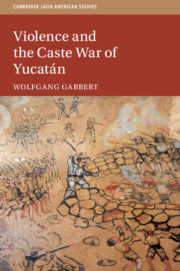Book contents
- Violence and the Caste War of Yucatán
- Cambridge Latin American Studies
- Violence and the Caste War of Yucatán
- Copyright page
- Dedication
- Contents
- Illustrations
- Acknowledgments
- Introduction: Caste War Violence – Prospect and State of the Art
- Part I Violence and War
- Part II Violence in Yucatán Before and Beyond the Caste War, 1821–1901
- Part III The Caste War and Violence: An Overview
- Part IV Violence and the Government Forces
- Part V Violence and the Kruso’b
- Part VI Intricacies of Caste War Violence
- Appendices
- Bibliography
- Index
- Other Books in the Series (continued from page ii)
Part I - Violence and War
Published online by Cambridge University Press: 09 August 2019
- Violence and the Caste War of Yucatán
- Cambridge Latin American Studies
- Violence and the Caste War of Yucatán
- Copyright page
- Dedication
- Contents
- Illustrations
- Acknowledgments
- Introduction: Caste War Violence – Prospect and State of the Art
- Part I Violence and War
- Part II Violence in Yucatán Before and Beyond the Caste War, 1821–1901
- Part III The Caste War and Violence: An Overview
- Part IV Violence and the Government Forces
- Part V Violence and the Kruso’b
- Part VI Intricacies of Caste War Violence
- Appendices
- Bibliography
- Index
- Other Books in the Series (continued from page ii)
Summary
Organized groups of combatants such as warrior bands or armies are shaped by violence in at least two ways. One is their capacity to exert force against outsiders when, for instance, enemies are attacked or the squad is defended against external aggression. Violence is also frequently applied to group members to establish and maintain the internal hierarchy and uphold discipline. The chapter also discusses factors that foster the use of violence, such as the social or cultural distance between the conflicting parties, the dehumanization of the opponent or the reduction of personal responsibility by explicit orders or tacit encouragement. Civil wars differ from interpolity wars insofar as the contending parties are “subject to a common authority at the outset of the hostilities” (Kalyvas 2006:5). They frequently imply guerrilla tactics and counter-insurgency strategies that are particularly savage, with a disproportionate share of non-combatant victims. In addition, the violence here is “more intimate,” often among people with a high degree of closeness and peaceful interactions.
- Type
- Chapter
- Information
- Violence and the Caste War of Yucatán , pp. 15 - 22Publisher: Cambridge University PressPrint publication year: 2019

